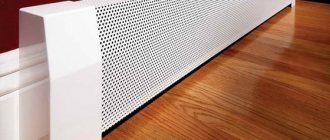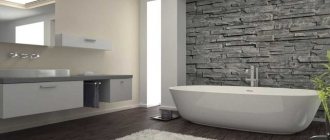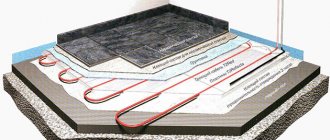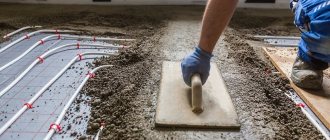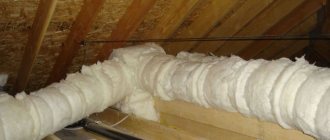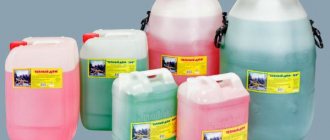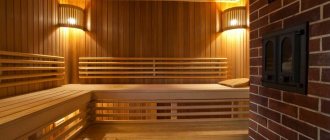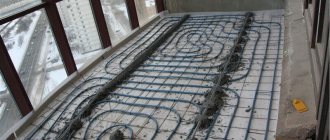Warm floor in the bathroom - this is a dream not only for apartment residents, but also for residents of private houses. Tile is traditionally used as flooring indoors, as it withstands regular exposure to moisture. However, there is also a significant drawback: the tile remains cold even in the hottest summer, and in winter it turns into a real test for those who love warmth.
For this reason, many connoisseurs of comfort are seriously thinking about how to lay a heated floor in the bathroom under the tiles. What is needed for this and how it can be implemented is further in the article.
Warm floors: basic information
The fashion for heated floors appeared relatively recently, but is already firmly established. The reason for such popularity is that they provide the most natural and pleasant heating for the human body: from the bottom up. This fact alone is the answer to the question of whether it is worth installing a heated floor under the bathroom.
Warm floors are laid based on the following factors:
- do the walls go outside?
- what floor temperature is needed;
- room size.
Depending on this, the method of laying the system is selected. Specifically, there are three types;
- snail;
- snake;
- double snake
The snake is more preferable, since it is it that allows you to compensate for the cooling from the external walls: the frequency of the turns will increase the heating in this area.
An example of pipe arrangement in a snake
In the case of a bathroom where it is constantly very humid, heated floors help solve a number of problems:
- Mold. Due to constant heat transfer, the air in the room dries out, which slows down the development of bending.
- Humidity. The presence of such floors solves the constant problem of high moisture content in the air.
- Discomfort after swimming. Putting your foot on a warm tile is much more pleasant than touching your skin to a cool surface.
When placing heated floors directly under a bathtub or shower stall, it is important to consider that in this case it must be possible to regulate the temperature. Installing heated floors in a bathroom without a thermostat may result in the bottom of the bathtub or shower stall being too hot.
What to consider before starting work
First of all, we need to mention what types of underfloor heating are used to heat tiles in the bathroom. Among all the variety, the most effective are:
- water floors;
- electric floors;
- infrared floors.
The advantages and disadvantages will be discussed in more detail below.
Depending on what kind of heated floor in the bathroom you plan to install, the first stage depends. Thus, water floors cannot be installed in all apartments.
Old buildings often do not allow such changes, since interference with the local heating system can render the entire building unusable. Due to the pressure drop in the riser, the upper apartments may be left without heating.
Sometimes this is possible, but a heated floor for a water-type bathroom may require the installation of a pump. You should find out from the housing office whether it is allowed to install heated floors in an apartment.
Private houses do not have this problem, but it is still worth thinking through a plan for the location of the pipes in advance - this will allow you to organize efficient heating of the entire room.
Schematic representation of floor connections in a private house
Water heated floor: advantages and disadvantages, installation
Water heated floors in the bathroom are considered a classic, as they appeared before all other types. In fact, it is a continuation of the heating system.
The advantages of this floor include:
- Durability. Provided proper installation and correctly selected pipes, such a system can operate in trouble-free mode for a long time.
- Uneven heat distribution. The water gradually cools, which makes it possible to intensively heat areas near the walls facing outside and evenly warm the rest of the area.
- Saving on utility bills. Water heated floors in the bathroom will only slightly increase the final cost.
Having mentioned the positive aspects, the disadvantages of this type of heating should also be cited:
- Difficult to install. Installation requires leveling the floors, good thermal insulation, reliable welding and thoughtful pipe placement. Violation of any of these points may result in problems during operation.
- Expensive. Taking into account all the materials involved and the expensive cost of the pipes themselves, laying a heated floor in a bathtub under tiles will cost a large sum.
- Installation restrictions. As mentioned above, such a system cannot be installed in all apartments.
In order to install a water heated floor in the shower, you will need to carry out a number of works. First of all, for proper functioning you will need a perfectly flat floor.
Any slope can affect the flow of water in the system, resulting in uneven heating.
If necessary, apply thermal insulation.
Additionally, a special apparatus is installed through which warm water enters the system and cold water is heated. The temperature is also adjusted.
The laying of pipes should be carried out by specialists, since the durability of the system depends on the quality of welding. The sharpness of the turn is also taken into account - too sharp a bend increases the risk of leaks.
Water floor made of flexible pipes
After the system is ready, water is released through it for testing. If everything is in order, then it turns off and is filled with screed. The heated bathroom floor should not be turned on until the mixture has completely hardened. Otherwise, this may lead to the formation of cracks and cavities in the screed layers.
The floor covering is already placed on top of the frozen surface. As a rule, such a system is connected from central heating, but you can also install heated floors in the bathroom from a heated towel rail. It is important to note that in any case it is necessary to obtain a work permit, since such actions are considered redevelopment.
How to install liquid heating?
For a “warm floor” under the shower stall, choose a contour made of cross-linked or heat-resistant polyethylene. The metal pipeline is not installed. Polyethylene is chosen cross-linked through peroxides. It is most resistant to temperature changes, is elastic and durable. Diameter 16 mm. Step 10-15 cm.
- Installing a floor water line will increase the height of the floor, so it is recommended to dismantle the old covering. A waterproofing membrane and insulation are laid on the base. A thin concrete screed 5 cm deep is made, or a self-leveling floor is made.
- A mastic is applied to the coating, which has water-repellent properties. Polystyrene boards 3 cm thick are chosen as thermal insulation. They are protected from condensation with plastic film.
- To direct all the heat upward, use a foil backing.
- Install means of securing the pipeline, cover the pipeline with a concrete screed at least 8 cm deep, or with tile adhesive 5 cm thick.
- Experts warn that the water circuit under the shower stall will be inclined.
Some cabin models require the installation of a bowl or tray. She has a high weight. It is not recommended to lay a highway under it. If the bowl is installed on legs, then there are no restrictions for installing a liquid heating system.
The pipeline is equipped with a double “snail” or “snake”. It is taken out of the room and connected to the distribution comb. To do this, fittings are installed at the ends of the pipes. It is recommended to choose products made of brass. The diameter must match the size of the outlet pipes on the manifold.
To install fittings, use the soldering method. Polyethylene has a “memory” effect. He always returns to his original position. No sealants are used during installation.
The comb is connected to the boiler via metal pipes with a diameter of 26 mm. The connection to the collectors is carried out using a threaded method. If water heating is installed in all rooms, then a separate circuit is installed in the bathroom. It requires separate connections to the supply and return manifolds.
We recommend: What is a self-leveling heated floor?
Separation with other circuits is necessary in order to control the thermal conditions in the room. If the normal air temperature in the living room is 22-24 0C, then for the bathroom it is maintained at 30 0C.
Electric floor: features and installation
Electric heated floors in the bathroom are a relatively modern type of heating. Unlike a water floor, an electric floor is much easier to install and operate. Its advantages include:
- Easy installation. Installing a heated floor in a bathroom is much simpler than a water floor. Preparatory work is minimal.
- Uniform heating. Due to the use of cable, the entire floor surface will have the same temperature.
- There is no need to obtain permits. Installation of an electric floor is not considered remodeling.
- Price. The purchase of components and building materials will be much cheaper compared to water floors.
Despite the impressive list of advantages, the electric floor also has its disadvantages:
- Communal payments. Powered by a common network, such a floor consumes a lot of energy.
- The need to conduct a separate branch of the electricity supply. This type of flooring requires a certain voltage in the network.
- Restrictions on furniture placement. If you plan to place a cabinet in the bathroom, you should take into account that it will be subjected to intense exposure to fairly high temperatures.
In addition, many people have concerns about whether it is safe to install electric heated floors in the bathroom. Yes, it is absolutely safe, since the electrical cable is hidden under a layer of screed and will have neither direct contact with water nor with humans.
Installation of thermal insulation
Installation of a heated floor in a bathroom begins with a separate power supply line. It is to this that an electrical cable and thermostat will later be connected, with which it will be possible to accurately regulate the temperature. Heat-insulating material is laid on the surface, thereby avoiding heat loss and directing it in the right direction.
Electric floor covering with tiles
After this, the cable itself is attached using a special mounting grid. In this case, the bend angle does not affect the efficiency of the system. The final stage consists of pouring the screed and laying the floor covering.
Popular myths
As practice shows, people are afraid to use TP for bathrooms for two reasons. But both are mere fiction. And now we will explain why.
- Electricity underfoot in a room with high humidity. Roughly speaking, a person is afraid of being shocked. There is no need to be afraid of this, since the heating cables are made with several layers of polymer insulators. Plus, they are grounded and protected by screens. In the upper layers of insulation, which is made of PVC, the coating is created in such a way that moisture does not penetrate inside. Add to this a layer of the screed itself, tile adhesive and tiles. As a result, electricity will not get anywhere near your feet. In order to finally convince yourself of the safety of the system, do not spare money on a good cable and a double screen on it.
- High energy consumption. The second common myth is that the underfloor heating system consumes a large amount of electricity, and therefore you have to pay a lot of money for its use. But in reality, you don’t have to use a lot of energy to heat a floor laid with ceramic tiles. Due to thin layers, heating is carried out quickly. Plus, the systems are equipped with a thermostat, and all TPs have switches. That is, you turn on the heating when it is needed, then turn it off. Believe me, the numbers in receipts for electricity payments will not change after installing the “warm floor” system. But the level of comfort when taking a shower will increase significantly.
Well, a warm floor has every right to its presence even in the shower. This makes water procedures more comfortable; there is no strong temperature drop when leaving the water. Plus, TP additionally affects the preservation of an attractive interior. It’s no secret that moisture has a destructive effect on even the highest quality finishing materials, furniture and plumbing fixtures.
Of course, it is better to entrust the installation of such a system to specialists of the appropriate profile. They will select the optimal materials, calculate the necessary parameters and perform the work at the highest level.
A shower without a tray is a convenient solution that saves space and gives the shower a more aesthetic appearance. Water flows down an inclined plane, decorated with ceramic tiles, into a specially designed drain (ladder) and is discharged into the general sewer system. Since moisture has direct contact with the surface, high-quality waterproofing of a shower without a tray is first of all necessary. For this, various insulating materials are used, each of which, when used correctly, can provide reliable moisture protection for the room.
The bathroom usually does not have a large area, especially in older houses. Therefore, every square meter here is worth its weight in gold. A factory tray usually takes up a lot of space in the shower. At the same time, it does not provide much useful space, and therefore many refuse this attribute, preferring a shower without a tray.
The absence of a bulky element contributes to a more interesting organization of the interior space. In addition, such a shower creates additional convenience for people with weak physical abilities, since in this case there is no need to step over the high side.
From an economic point of view, a shower without a tray also has its advantages. This attribute (pallet), made of high-quality material, costs a lot of money. In addition, it requires constant care, which requires additional costs. Therefore, its absence saves money in the family budget.
Shower without tray - the optimal solution for saving space and money
Infrared floors: device, characteristics and installation methods
An infrared heated floor in a bathroom is a subtype of an electric one, but instead of a cable, a special film is used, in which graphite inserts are located. It is called infrared because of the spectrum in which it operates. Due to this, natural and pleasant heating is provided to the human body. Just like the cable type, infrared is adjustable and is able to produce exactly the temperature that the homeowner finds comfortable.
What are the advantages of such floors? Film heated floors in the bathroom have the following features:
- Easy installation. This floor can be placed directly on top of the old floor covering; leveling the base is not required. Some types of flooring can be plugged into a regular outlet.
- Availability. Film type heated floors can be bought in a store without any problems.
- Reliability. Graphite inserts are not interconnected, so failure of one element does not affect the performance of the entire system.
Just like electric cable heated floors for the bathroom, infrared ones are not considered a remodel, which greatly simplifies the entire installation process.
Installation does not require any special skills, so it is quite possible to install a heated floor in the bathroom with your own hands.
Installation of infrared heated floor
The main condition for high-quality installation is thermal insulation. In some models of film floors, protection against heat “leakage” is already provided in advance.
The floors themselves can be placed on not entirely flat surfaces. Any floor covering is allowed on top; there is no need to place any screed on top of the system.
The only drawback of heated floors is its relative fragility.
Using mats
Cable or carbon mats are used for heating. Cable systems consist of a mesh on which a conductor is installed. A mat of a certain size is cut from the roll. The connection to the conductor is parallel.
The connection unit requires plastic couplings, which are insulated with bitumen tape. Corrugated tubes are used for additional protection.
Carbon mats are made of individual rods that are connected to each other by wire. The connection is the same as for cable mats, parallel. All units are insulated and protected with corrugation.
A temperature sensor is installed between the rods or turns of the cable. All conductors are taken out of the room and connected to the regulator; use RCD. The system is covered with an adhesive solution and the tiles are laid.
It is not recommended to correct the mats or damage the integrity of the heating elements. If the area of the room is smaller than the size of the mats, and it is not possible to meet all the standards, then use another system.
We recommend: What myths exist about the dangers of heated floors?
The optimal heating for a shower cabin is liquid underfloor heating. In city apartments, electric heaters are used, but they are not installed under the cabin or under the bathtub. The system is installed only on the usable area.
YouTube responded with an error: The request cannot be completed because you have exceeded your quota.
- Related Posts
- How to calculate the power of a heated floor?
- How is a heated floor connected?
- Features of heated floors made of metal-plastic pipes
- What is film heated flooring?
- How to lay polystyrene foam for heated floors?
- What kind of base can be used for a heated floor?
What flooring is best for a bathroom?
If you have a desire or need to install a heated floor in the bathroom, a simple factor will help you decide which one is best: temperature control.
Water floors are the most difficult type to install, because for this:
- special permission will be required;
- you will need to level the base for installation;
- The central heating system will need to be rebuilt.
Installing a heated floor in a bathroom like this will take a lot of time and require a significant investment.
Cable type electric floors are more preferable. Because they are less picky about installation conditions. In addition, this type is equipped with a thermostat - a device that allows you to control the temperature of the floor heating. Due to this, comfortable conditions can be ensured at any time of the year.
Infrared heated floors under tiles are one of the simplest options. It actually does not require preliminary preparation, is equipped with a temperature regulator and is safe for humans. With proper thermal and waterproofing, such floors can last quite a long time.
